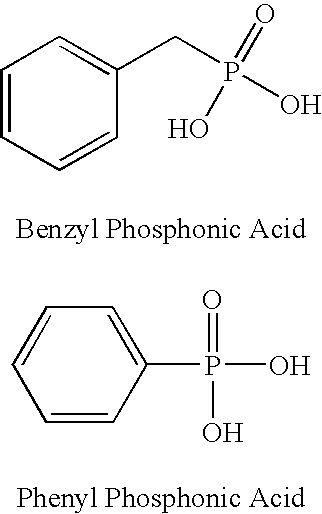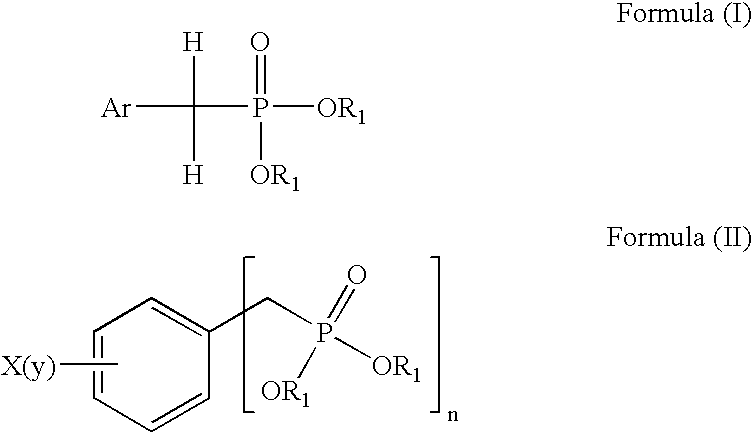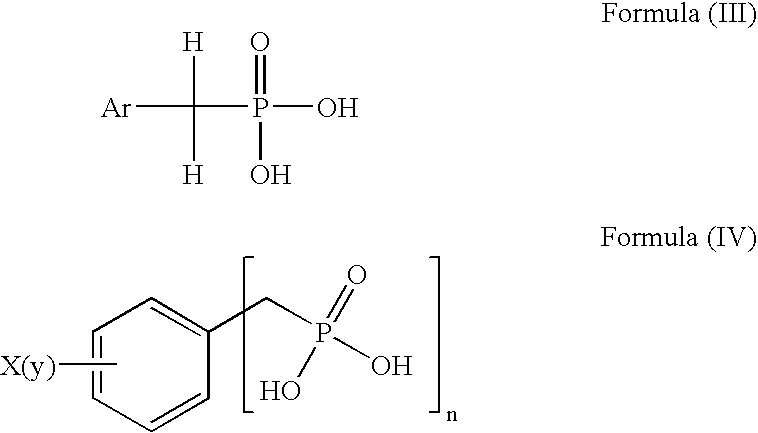Methods for the preparation of phosphonic acid derivatives
a technology of phosphonic acid and derivatives, which is applied in the field of preparation of aralkyl phosphonic acid and aryl phosphonic acid derivatives, can solve the problems of contaminating the final product, affecting the quality of the final product,
- Summary
- Abstract
- Description
- Claims
- Application Information
AI Technical Summary
Benefits of technology
Problems solved by technology
Method used
Image
Examples
example 1
Preparation of Benzyl Phosphonic Acid
[0021] 40 mL of concentrated hydrochloric acid was added to 15 grams of benzyl diethyl phosphonate in a 100 mL round bottom flask. The resulting mixture was refluxed at about 100-110° C. with for about 28 hours under a nitrogen atmosphere and stirred using a magnetic stir bar. The reaction mixture was cooled to room temperature and the solid crystals were separated from the non-solids via filtration on a Whatman 54 filter paper using a Buchner funnel. The resulting solids product was washed with 10 mL of cold water and then vacuum dried (˜20 mm Hg) at about 60-70° C. for 16 hours. The isolated product weighed 9.87 grams (87% yield), and exhibited a melting point of about 175-177° C. NMR studies were consistent with the known structure of benzyl phosphonic acid.
example 2
Preparation of Phenyl Phosphonic Acid
[0022] A 250 mL 3-neck flask was fitted with an addition flask and a water condenser. 120 mL of a nitric acid:water mixture (1:4 ratio by weight) and a magnetic stir-bar were placed in the 250 mL 3-neck flask. 41.1 grams of benzene phosphorus dichloride was placed in the addition flask. Benzene phosphorus dichloride was slowly dripped into the stirred dilute nitric acid:water mixture during about 1.5 hours, while maintaining the reaction temperature below about 50° C. An exothermic reaction was observed, which was controlled externally using an ice-water bath. Once the benzene phosphorous dichloride addition was completed, an exotherm was observed with the evolution of nitrogen oxide fumes. The reaction mixture self-refluxed at 80-120° C. for 30 minutes and then was allowed to cool to room temperature (˜22.5° C.). Solid crystals formed during the reaction were separated from the non-solids via filtration and then water washed. The crystals were ...
PUM
 Login to View More
Login to View More Abstract
Description
Claims
Application Information
 Login to View More
Login to View More - R&D
- Intellectual Property
- Life Sciences
- Materials
- Tech Scout
- Unparalleled Data Quality
- Higher Quality Content
- 60% Fewer Hallucinations
Browse by: Latest US Patents, China's latest patents, Technical Efficacy Thesaurus, Application Domain, Technology Topic, Popular Technical Reports.
© 2025 PatSnap. All rights reserved.Legal|Privacy policy|Modern Slavery Act Transparency Statement|Sitemap|About US| Contact US: help@patsnap.com



